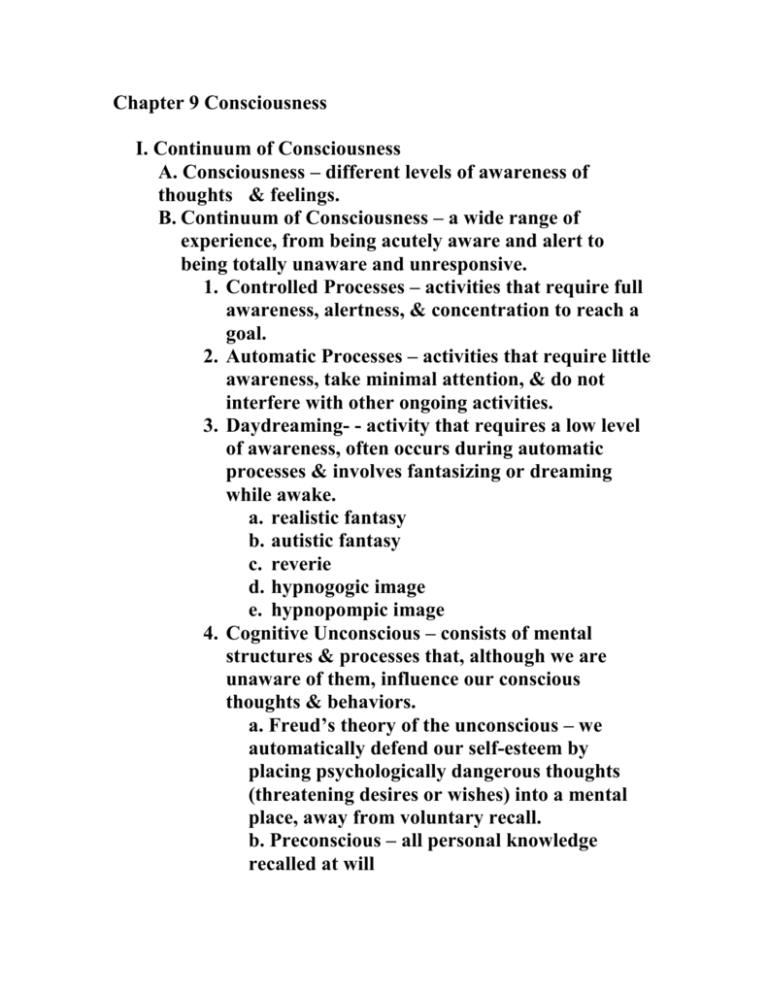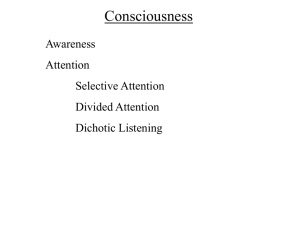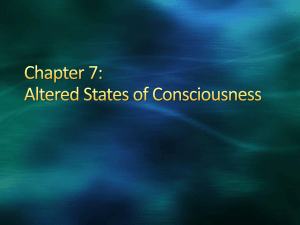Chapter 9 Consciousness
advertisement

Chapter 9 Consciousness I. Continuum of Consciousness A. Consciousness – different levels of awareness of thoughts & feelings. B. Continuum of Consciousness – a wide range of experience, from being acutely aware and alert to being totally unaware and unresponsive. 1. Controlled Processes – activities that require full awareness, alertness, & concentration to reach a goal. 2. Automatic Processes – activities that require little awareness, take minimal attention, & do not interfere with other ongoing activities. 3. Daydreaming- - activity that requires a low level of awareness, often occurs during automatic processes & involves fantasizing or dreaming while awake. a. realistic fantasy b. autistic fantasy c. reverie d. hypnogogic image e. hypnopompic image 4. Cognitive Unconscious – consists of mental structures & processes that, although we are unaware of them, influence our conscious thoughts & behaviors. a. Freud’s theory of the unconscious – we automatically defend our self-esteem by placing psychologically dangerous thoughts (threatening desires or wishes) into a mental place, away from voluntary recall. b. Preconscious – all personal knowledge recalled at will 5. Unconsciousness – a state which results in total unawareness & loss of responsiveness to the environment 6. Sleep & Dreams 7. Altered States of Consciousness – result from using a variety of procedures – meditation, hypnosis, psychoactive drugs, sleep deprivation – produce an awareness that differs from normal consciousness. II. Rhythms of Sleeping & Waking A. Biological Clocks – internal timing devices that are genetically set to regulate various physiological responses for different periods of time. a. Circadian Rhythm – a biological clock that is generally programmed to regulate physiological responses within a time period of 24 – 25 hours. a. This clock is located in the SCN (suprachiasmatic nuclei) of the hypothalamus. b. The SCN regulates the secretion of melatonin (hormone) from the pineal gland. c. Jet Lag d. Light Therapy III. World of Sleep A. Stages of Sleep (see page 299) 1. Alpha Stage – relaxed & drowsy state, usually with eyes closed. Alpha waves have low amplitude & high frequency (8-12 c/s). 2. Non-REM Sleep – we spend approx. 80% of our sleep time in this stage; may experience images or brief periods of dreaming. a. Stage 1 – transition from wakefulness to sleep; lasts 1-7 mins.; theta waves present (4-7 c/s). b. Stage 2 – marks beginning of what we know as sleep; sleep spindles c. Stage 3- stage that occurs 30-45 mins. After falling asleep; consists of delta waves (high amplitude & low frequency waves. d. Stage 4 – deepest stage of sleep; delta waves present (,4 c/s); sleepwalking & sleeptalking occur. 3. REM Sleep (Rapid Eye Movement) – makes up the remaining 20% of sleep time; occurs 5-6 times throughout the night; lasts for 15-45 mins. ; followed by non-REM sleep; low amplitude/high frequency waves present that are similar to beta waves (13-30 c/s) a. REM rebound – suggests need for REM sleep. b. Also called paradoxical sleep due to general state of arousal. c. Consists of long, vivid, & complicated dreams (nightmares). B. Questions About Sleep 1. Morning or Evening Person? a. body temperature b. behavioral differences 2. Sleep Needed a. Infancy/childhood – newborn: 17 hrs/ 50%REM 4-yr.-old: 10 hrs/ 25-30% REM b. Adolescence/adulthood – 7.5 hrs/ 20% REM c. Old age (age 60) – 6.5 hrs / 20% REM 3. Theories for Sleep a. repair theory – sleep is primarily a restorative process. (proof: secretion of GH during stage 4 non-REM). b. Adaptive theory – sleep evolved because it prevented early humans & animals from wasting energy & exposing themselves to dangers of predators. 4. Effects of Sleep Deprivation a. On the body – immune system affected; minimal effect on heart rate, BP & hormone secretions b. On the brain – interferes with concentration; mild hallucinations (60 hrs or >). 5. SAD (Seasonal Affective Disorder) – a pattern of depressive disorders that cycle with the seasons. a. Symptoms include: depression, lethargy, excessive sleepiness, overeating, weight gain & craving carbos. b. Triggered by decrease in daylight. (FL – 1.4%; NY – 7.3%) C. World of Dreams 1. Everyone Dreams 2. Theories of Dream Interpretation a. Freud’s theory – we dream for wish fulfillment disguised as symbols (manifest content/latent content); no role in problemsolving. b. Dreams are extensions of Waking Life – dreaming is primarily a time for working out problems (Cartwright). c. Activation-Synthesis theory – dreaming is the result of the random & meaningless activity of nerve cells in brain; pons cortex feelings, perceptions, images (Hobson & McCarley). d. Revision of theory (Hobson) – deep personal significance; dreams reflect past memories & personal view of world. e. Dreams are ways to enter the spiritual world – forces in spiritual world help a person reflect on present or future events (Inuit tribe). D. Sleep Disorders & Treatments 1. Insomnia – difficulty in falling asleep or staying asleep. a. Drug treatment – benzodiazepines (Librium, Valium, Xanax): reduce anxiety; relatively safe for short periods of time. 2. Sleep Apnea – episodes during sleep when a person stops breathing for 10 seconds or longer. 3. Sleepwalking – usually occurs in stage 4 or delta sleep; sleepwalkers have poor coordination but can avoid objects & engage in conversation. 4. Night Terrors – occur in stage 3 or 4 or delta sleep; common in children aged 4-12. 5. Nightmares – occur during REM sleep; usually involve great danger. 6. Narcolepsy – falling suddenly asleep throughout the day; sleep attacks are accompanied by brief periods of REM & muscle paralysis. a. Cause is unknown; condition runs in families. b. Treatment – stimulant drugs. 7. SIDS (Sudden Infant Death Syndrome) – a sleeping baby stops breathing & dies. a. About 1/2 the apparent SIDS cases may be accidental suffocations. b. Other cases may involve exposure to cigarette smoke. 8. REM Behavior Disorder – the near paralysis that accompanies REM sleep is absent. IV. Altered States of Consciousness A. Meditation – a method of refocusing attention to produce relaxation or a heightened state of spirituality (to enter an inner consciousness). B. Hypnosis – a situation or set of procedures in which a hypnotist suggests to another person that he/she experience various changes in sensation, perception, cognition, or control over motor behaviors. 1. Under hypnosis some people will carry out suggestions in the subsequent waking state calling post-hypnotic suggestion 2. By suggestion, even a memory can be suppressed (post-hypnotic amnesia). 3. How hypnosis works: a. Role (-enactment) theory – hypnosis is an extreme form of role playing (cognitivebehavioral); it provides a socially acceptable reason for following someone’s suggestion(s). b. State theory – hypnosis is an altered state of consciousness; e.g. insensitivity to pain, response to cue word. c. Dissociation theory – consciousness splits (dissociates) into several independent systems. The hypnotist is allowed to control some of these experiences – social agreement. 4. Applications of Hypnosis a. For some people, it relieves the pain (hypnotic analgesia) of dental work, childbirth, burns, abdominal surgery, arthritis, nerve damage, migraines & cancer. b. May reduce nausea and vomiting due to chemotherapy and asthma attacks. c. Clients who are highly susceptible to hypnosis generally respond better to suggestions aimed at treating a wide range of psychosomatic problems, which involve mind-body interactions. d. Hypnosis is not as successful with problems of self-control: quitting smoking, overeating, and drinking. e. Useful in helping clients relieve tension, reveal personalities, gain insight into their lives, & arrive at solutions to their problems. f. Not reliable in age regression and in eyewitness testimony. C. Psychoactive Drugs – change consciousness by altering chemistry of the brain. (page 316) 1. Types (* = Highly addictive) a. Depressants – Slow CNS functioning; decreased alertness & reaction speed (alcohol*, hypnotics, tranquilizers, narcotics – barbiturates*) b. Stimulants – increase heart rate, BP & muscle tension, (i.e. nicotine*?, caffeine, cocaine, amphetamines, MDMA) c. Opiates* - effective painkiller & sleep inducer (depresses activity in areas of cerebral cortex) and creates euphoria (opium, morphine, heroin, codeine). d. Psychodelics (Hallucinogens/ Psychotomimetics) – Powerful visual & sensory changes; produce hallucinations (LSD, PCP, mescaline, peyote, psilocybin, marijuana). (i) Marijuana – Enhances sensory stimuli, can heighten both pleasant & unpleasant sensations; disrupts memory formation; effects vary with person & setting. (2) Effects- tolerance, addiction (physical dependence), withdrawal symptoms, psychological dependency. (3) Effects on Nervous System (a) Drugs increase the release of neurotransmitters. (cocaine norepinephrine) (b) They mimic the action of neurotransmitters – agonists. (morphine = endorphins) (c) They block receptors – antagonists. (LSD) (d) Drugs block the removal of the neurotransmitter. (cocaine, amphetamines decrease reuptake) The Truth About Hypnosis Myth # 1 Loss of Consciousness Myth # 2 Hypnotized people do odd and crazy things. Myth # 3 Surrender of the will, loss of control. Myth # 4 Weakmindedness Myth # 5 Revelation of secrets Myth # 6 Fear of getting “stuck” in hypnosis. Myth # 7 Hypnosis weakens the will. Myth # 8 Hypnosis is habit forming. Myth # 9 Repeated inductions weaken the mind. Myth # 10 A person can be hypnotized against their will. Myth # 11 Criminal and immoral acts can de induced by hypnosis.




